 Software Tutorial
Software Tutorial
 Office Software
Office Software
 How to calculate the coordinates of intersection points of scatter plot curves in Excel
How to calculate the coordinates of intersection points of scatter plot curves in Excel
How to calculate the coordinates of intersection points of scatter plot curves in Excel
php editor Zimo introduces to you the method of calculating the coordinates of the intersection point of the scatter plot curve in Excel. In data analysis, scatter plots and curve charts are often used to represent relationships, and intersection coordinates can help us understand the relationship between data more intuitively. With the following method, you can easily calculate the intersection coordinates of scatter plots and curve plots, providing deeper insights for data analysis.
1. There are current curves with different loads when the elevator is running. The current value is the Y-axis, the load-to-load ratio is the X-axis, and the current of 30%, 40%, 45%, 50%, and 60% of the load when the elevator is going up. Generate a curve. When the elevator goes down, the current of 30%, 40%, 45%, 50%, and 60% load generates a curve. Then the two curves will have an intersection point. The X-axis of the intersection point needs to be calculated in the Excel cell. value. As shown in the figure: Calculate the x-axis value of the intersection point.
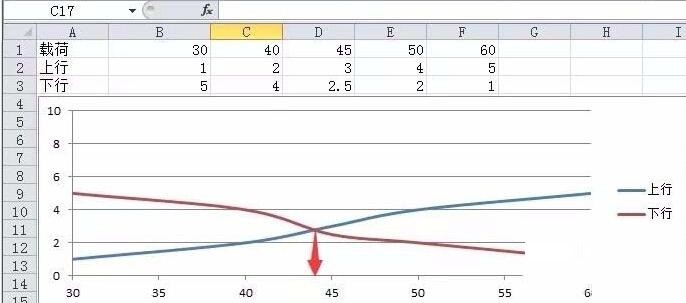
2. From the figure, you can intuitively see that the intersection point is between the loads (40-50) - the yellow area in the above figure. Keep the data in the yellow area in the red box. , and other deletions. This step is to lock a relatively small range and reduce the difficulty of solving; the deleted graph is as follows:

3. Add a fitting curve (actually it is also based on higher-order equations) (to solve based on the principle of point fitting), the adding method is as shown in the figure:
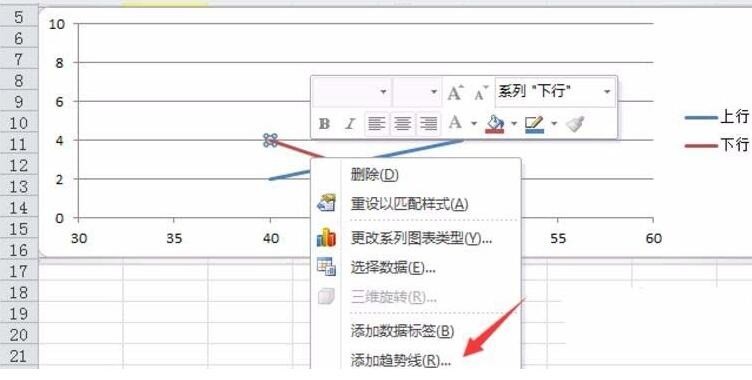
4. Add a trend line, select a polynomial, and display the formula. The purpose is to use polynomials to fit the original curve.

5. In the same way, add the polynomial trend to another line and display the formula.
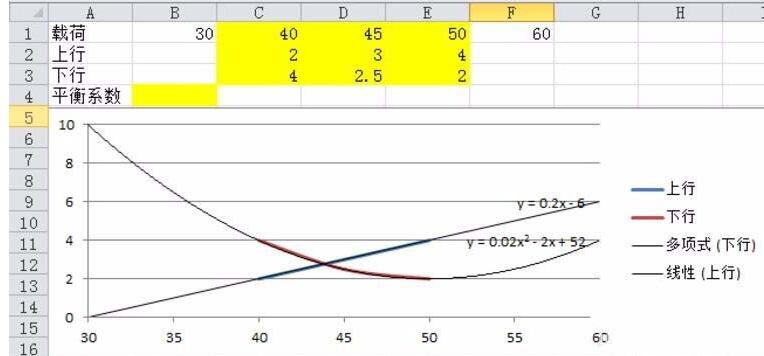
6. At this time, you can get a system of equations: y = 0.2x - 6...(1)y = 0.02x^2 - 2x 52...(2) Use excel By solving the system of equations (1) (2), the intersection position of the fitting curve can be calculated, which is the [balance coefficient].
2. Solve the system of equations in Excel
1. The system of equations (1)(2) is organized into equations: 0.02x2 - 2.2x 58 = 0
2. Select In cell B4, enter X in the name box (note the [name box] in the upper left corner), as shown in the figure:

3. Enter the formula =0.02*X^ in cell B5 2-2.2*X58.
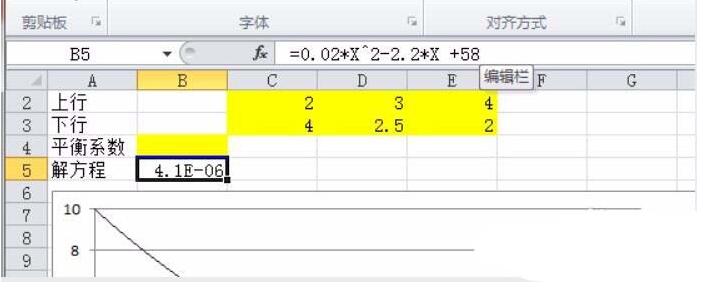
4. Solve
Target cell: B5
Target value: 0
Variable cell: B4
Click [OK] and the balance coefficient is 43.82

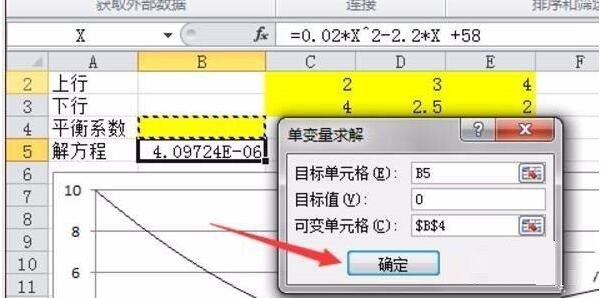
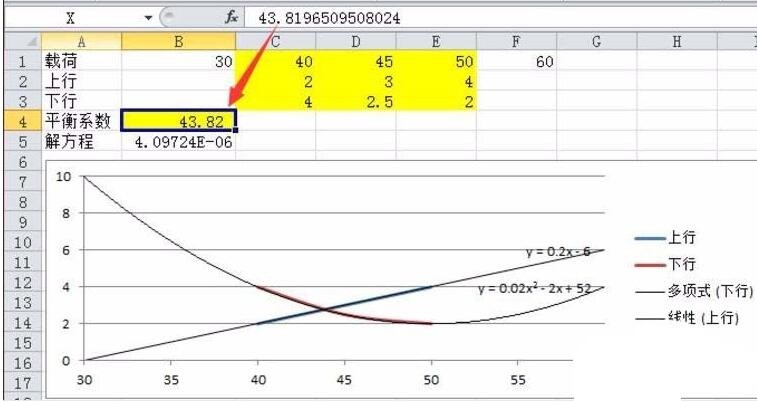
The above is the detailed content of How to calculate the coordinates of intersection points of scatter plot curves in Excel. For more information, please follow other related articles on the PHP Chinese website!

Hot AI Tools

Undresser.AI Undress
AI-powered app for creating realistic nude photos

AI Clothes Remover
Online AI tool for removing clothes from photos.

Undress AI Tool
Undress images for free

Clothoff.io
AI clothes remover

Video Face Swap
Swap faces in any video effortlessly with our completely free AI face swap tool!

Hot Article

Hot Tools

Notepad++7.3.1
Easy-to-use and free code editor

SublimeText3 Chinese version
Chinese version, very easy to use

Zend Studio 13.0.1
Powerful PHP integrated development environment

Dreamweaver CS6
Visual web development tools

SublimeText3 Mac version
God-level code editing software (SublimeText3)

Hot Topics
 How to Create a Timeline Filter in Excel
Apr 03, 2025 am 03:51 AM
How to Create a Timeline Filter in Excel
Apr 03, 2025 am 03:51 AM
In Excel, using the timeline filter can display data by time period more efficiently, which is more convenient than using the filter button. The Timeline is a dynamic filtering option that allows you to quickly display data for a single date, month, quarter, or year. Step 1: Convert data to pivot table First, convert the original Excel data into a pivot table. Select any cell in the data table (formatted or not) and click PivotTable on the Insert tab of the ribbon. Related: How to Create Pivot Tables in Microsoft Excel Don't be intimidated by the pivot table! We will teach you basic skills that you can master in minutes. Related Articles In the dialog box, make sure the entire data range is selected (
 You Need to Know What the Hash Sign Does in Excel Formulas
Apr 08, 2025 am 12:55 AM
You Need to Know What the Hash Sign Does in Excel Formulas
Apr 08, 2025 am 12:55 AM
Excel Overflow Range Operator (#) enables formulas to be automatically adjusted to accommodate changes in overflow range size. This feature is only available for Microsoft 365 Excel for Windows or Mac. Common functions such as UNIQUE, COUNTIF, and SORTBY can be used in conjunction with overflow range operators to generate dynamic sortable lists. The pound sign (#) in the Excel formula is also called the overflow range operator, which instructs the program to consider all results in the overflow range. Therefore, even if the overflow range increases or decreases, the formula containing # will automatically reflect this change. How to list and sort unique values in Microsoft Excel
 If You Don't Rename Tables in Excel, Today's the Day to Start
Apr 15, 2025 am 12:58 AM
If You Don't Rename Tables in Excel, Today's the Day to Start
Apr 15, 2025 am 12:58 AM
Quick link Why should tables be named in Excel How to name a table in Excel Excel table naming rules and techniques By default, tables in Excel are named Table1, Table2, Table3, and so on. However, you don't have to stick to these tags. In fact, it would be better if you don't! In this quick guide, I will explain why you should always rename tables in Excel and show you how to do this. Why should tables be named in Excel While it may take some time to develop the habit of naming tables in Excel (if you don't usually do this), the following reasons illustrate today
 How to Format a Spilled Array in Excel
Apr 10, 2025 pm 12:01 PM
How to Format a Spilled Array in Excel
Apr 10, 2025 pm 12:01 PM
Use formula conditional formatting to handle overflow arrays in Excel Direct formatting of overflow arrays in Excel can cause problems, especially when the data shape or size changes. Formula-based conditional formatting rules allow automatic formatting to be adjusted when data parameters change. Adding a dollar sign ($) before a column reference applies a rule to all rows in the data. In Excel, you can apply direct formatting to the values or background of a cell to make the spreadsheet easier to read. However, when an Excel formula returns a set of values (called overflow arrays), applying direct formatting will cause problems if the size or shape of the data changes. Suppose you have this spreadsheet with overflow results from the PIVOTBY formula,
 Excel MATCH function with formula examples
Apr 15, 2025 am 11:21 AM
Excel MATCH function with formula examples
Apr 15, 2025 am 11:21 AM
This tutorial explains how to use MATCH function in Excel with formula examples. It also shows how to improve your lookup formulas by a making dynamic formula with VLOOKUP and MATCH. In Microsoft Excel, there are many different lookup/ref
 How to Use Excel's AGGREGATE Function to Refine Calculations
Apr 12, 2025 am 12:54 AM
How to Use Excel's AGGREGATE Function to Refine Calculations
Apr 12, 2025 am 12:54 AM
Quick Links The AGGREGATE Syntax
 How to change Excel table styles and remove table formatting
Apr 19, 2025 am 11:45 AM
How to change Excel table styles and remove table formatting
Apr 19, 2025 am 11:45 AM
This tutorial shows you how to quickly apply, modify, and remove Excel table styles while preserving all table functionalities. Want to make your Excel tables look exactly how you want? Read on! After creating an Excel table, the first step is usual






